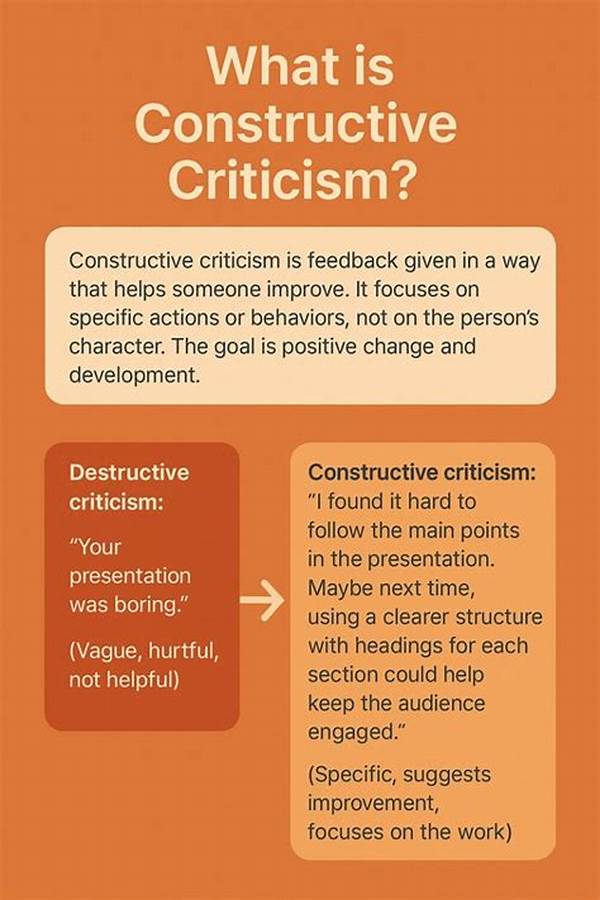Under the bright lights of the small, intimate theater, a young musician named Sarah stood with her violin, heart pulsating in rhythm with the audience’s expectant silence. Tonight was important. Her performance would be followed by a panel’s critique—a fair and challenging arena where constructive criticism for musicians like herself was the star attraction. As her fingers danced over the strings, weaving a tapestry of sound, she remembered her mentor’s words: “Criticism is the echo of the melody you play, an essential harmony to your success.”
Read Now : Interactive Audition Material Presentation
The Power of Constructive Criticism
In the hustle and bustle of artistic growth, where every note and lyric forms the blueprint of a musician’s journey, constructive criticism for musicians serves as a pivotal instrument. When Sarah wrapped up her performance, her mind was a cascade of emotions, mingling anticipation with a touch of vulnerability. Across the aisle, seasoned critics prepared to impart their insights—dawns breaking through the shadows of her nascent melody. Their words, like gentle rivers, flowed through the young musician’s consciousness, shaping her raw potential into refined art.
Constructive criticism for musicians, akin to sunlight nourishing a tender sapling, nurtures resilience and adaptability. Sarah recalled her mentor’s tales of master musicians who once stood in her shoes, sculpted by the chisel of critique. Each piece of advice was a stepping stone, guiding her through the intricate maze of melody making and storytelling. The critiques weren’t just observations; they were a map outlining a journey toward excellence, urging her to traverse paths less charted and explore harmonies unexplored.
Embracing constructive criticism is akin to opening the book of one’s own artistry, eager to script new chapters. It’s in these reviews that musicians like Sarah find their true voice, learning where their strengths shine and where opportunities for growth hide. This synergy of feedback and artistry forms a mosaic of self-improvement and authentic expression—a dynamic duo that propels a musician from mere notes to symphonic storytelling.
Understanding Constructive Criticism
1. Reflective Learning Journey: Through the echo of constructive criticism for musicians, they embark on a reflective journey that fosters self-discovery and artistic refinement, tracing every rhythm to its core.
2. Transformative Mirrors: These critiques act as mirrors, allowing musicians to witness their performances through the lens of seasoned experts, fostering a transformative artistic experience.
3. Harmonizing Growth: Embracing feedback catalyzes growth, harmonizing talent with skill, sculpting novices into maestros in the grand symphony of music.
4. Narrative Building: Constructive criticism for musicians, when embraced, aids in crafting a narrative, each note a story, each critique a new chapter unfolding.
5. Pathway to Excellence: It illuminates pathways to excellence, guiding musicians through uncharted musical territories, broadening their horizons with each critique’s whisper.
Crafting a Musician’s Journey through Critique
Sarah’s journey illustrates a universal truth within the musical realm: feedback is a compass. Constructive criticism for musicians, a treasure map where X marks their untapped potential. As the panel commenced their review, weaving encouragement with honest observations, Sarah listened intently. Each critic’s voice became a brushstroke painting the landscape of her future compositions.
Critiques are not barriers but bridges. For every musician who has felt the weight of vulnerability under scrutiny, these insightful reflections offer clarity. They transform a simple piece into a symphony, infusing each note with intent and each silence with anticipation. In the grand orchestra of life, constructive criticism for musicians is not a discordant note but a harmonious crescendo, elevating their artistry to new zeniths.
The echoes of constructive criticism remind musicians that every flaw is an opportunity cloaked in disguise, and every insight, a spark lighting the fuse to unparalleled creativity. Sarah, having soaked in every word like rain nourishing roots, knew her art was not just about individual performance; it was about collective evolution—the ongoing dialogue between artist and audience, enriched by critique.
Navigating the World of Musical Critique
In the intricate dance of notes that construct a musician’s repertoire, feedback is the partner guiding them across the floor of creativity. Constructive criticism for musicians is not merely an evaluative process but a narrative that unfolds, crafting tales of growth, wisdom, and artistry.
1. It’s a dialogue between the musician’s intent and the listener’s perception.
2. Acts as a spotlight illuminating unexplored musical ventures.
Read Now : “mindfulness Exercises For Choir Singers”
3. Encourages musicians to blend technical prowess with emotional depth.
4. It’s a gentle reminder of the fluid nature of art, ever-evolving.
5. Teaches resilience and the power of perspective in the face of critique.
6. Invites musicians to balance instinct with learned skill.
7. Marks the crossroads between aspiration and achievement.
8. Elevates performance from routine to remarkable.
9. Nurtures a community of shared learning and mutual respect.
10. Enhances the musician’s ability to connect emotionally with audiences.
A Symphony of Growth: The Role of Critique
For musicians like Sarah, the feedback received becomes an ever-present mentor, guiding each step on the improvisational journey of music and life. Constructive criticism for musicians shapes not just the sound but the artist behind it, crafting the resilience and humility needed to grow. As Sarah exited the theater, the night sky extended its starry applause; she carried with her a constellation of insights illuminating her musical path.
Every critique she had absorbed was a note in her grand symphony, and she understood that true mastery did not reside solely in technical proficiency but in the perpetual evolution fueled by critique. The artistry lay in transforming the criticisms into melodies that resonated with authenticity and depth, bridging the compositions with audiences worldwide.
Through the lens of constructive criticism for musicians, Sarah saw the labyrinth of music not as an obstacle but a series of challenges awaiting her interpretation. Each critique was a chapter of her metamorphosis, a reminder of the beauty in imperfection and the endless pursuit of artistic truth.
